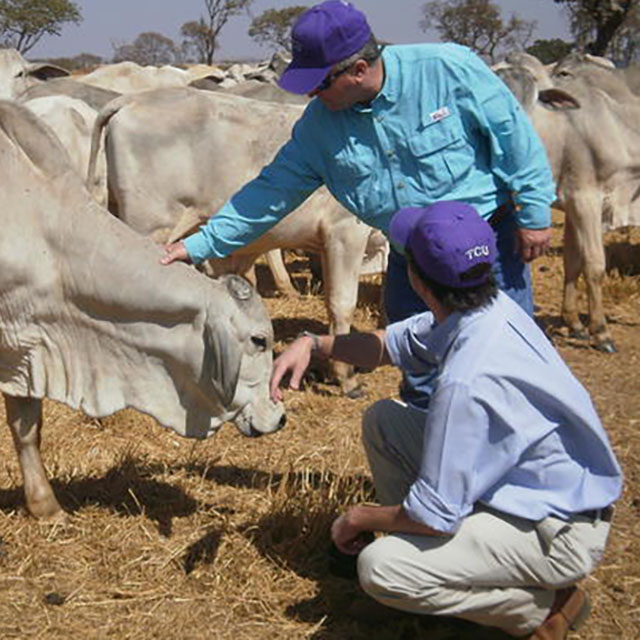The TCU Ranch Management Program conducts extensive research into farming and resource management (photo courtesy of TCU).

How much water does a head of cattle need? Depending on how hot it is outside, it can be up to 20 gallons a day, a whole lot more than the eight glasses of water you’re supposed to be drinking.
Coupled with huge population growth throughout the West, agriculture and ranching are huge users of aquifers and water storage reservoirs. Add historic droughts into the equation and the problem approaches crisis level.
Texas Christian University professor Jeff Geider has been focusing on the problem since long before the West dried up. “Water management is probably the single biggest issue facing agriculture all over the world,” he said.
His suggestion to farmers? Go natural, and strike a reasonable balance with the land and water they use to ensure their sustainability.
As head of the Institute for Ranch Management at the Fort Worth university, Geider has a unique perspective to draw from. The original Ranch Management field of study has been in existence for 60 years and focuses on Texas’ cattle ranching industry. The Institute grew out of the greater demand to create worldwide solutions for sustainable resource management for all manner of ranching and agriculture, especially water issues.
Over the years, the institute has responded to educational requests from many places in the world, leveraging its findings to teach actionable solutions to farmers.
“The Institute of Ranch Management promotes and teaches water resource management in mechanical and technical ways and stresses the importance of adding a ‘water conservation’ component to an overall management plan,” said Geider.
The Institute engages in partnerships with private industry, water districts and local governments regarding sustainable water management, all while training and educating along the way.
“The goal is to develop an international repository of technology and information that can be shared and applied to the development of sustainable agricultural enterprises worldwide.”
But the Institute doesn’t just focus on global solutions from the minds of tenured professors. Undergrad students are getting involved as well.
One former student and fifth-generation cattle rancher in Texas, Jesse Womack, has been working with Geider for more than a decade on the establishment of the Institute since his time as a student at TCU.
Womack brings his knowledge of the inner workings of the industry to assist the Institute on crafting and implementing its large-scale initiatives in locations across the globe.
“The Institute of Ranch Management has really gained a lot of momentum in the past few years,” Womack said. “In 2014, for example, Jeff and I each flew over 100,000 air miles.”
As they traveled, Womack and Geider discovered an increasing global demand for protein, especially in developing nations. With no infrastructure for large-scale livestock production in place, these countries will be relying heavily on imports for the foreseeable future, especially from the American west.
While this is good news for profits, it puts increased strain on the region’s water resources. The Institute understands that agriculture is business, but it urges renewable practices. To balance profits and limited resources, Geider recommends revamping traditional agriculture practices.
“Low-impact farming methods, selecting plants specifically designed to be grown in low rainfall areas and advanced irrigation systems are other ways to decrease the amount of water necessary for production,” Geider said. Picking grazing plants appropriate for the climate is a huge factor. For example, a water-wasting alfalfa crop for livestock feed can be replaced with naturally occurring grasses.
Geider suggested that using land in smart ways could actually help its natural water features. “Animal agriculture, when sustainably managed, can actually improve natural water resources such as ponds, streams and aquifers.” He went on to explain that maintaining a proper number of animals for the land is an important consideration, as well as responsibly maintaining grazing land to ensure it is not overtaxed.
That, Geider said, would return the landscape to its natural and balanced state.
Geider said the need for natural resource management and proper land stewardship has never been more important. With the world’s population expected to reach 9 billion by 2050, the Institute’s efforts to balance water use and agriculture is crucial.
“There is no question that increasing populations will impact the demand for water and all resources. The key to managing this competition is exactly trying to find a balance between the two,” he said.
If these sustainable practices become the new standard for agriculture, then the Institute has achieved what it set out to do.
“The ultimate goal of the Institute is to teach ourselves out of a job,” Womack said.
—Alicia Doyle, Tribune Content Solutions
See more at: LA Times